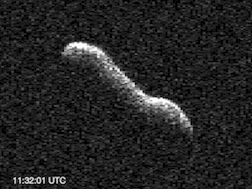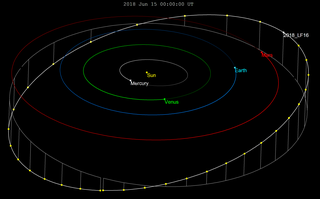Related Research Articles
(89959) 2002 NT7 (prov. designation:2002 NT7) is a near-Earth object with a diameter of 1.4 kilometers and potentially hazardous asteroid of the Apollo group. It has a well determined orbit with an observation arc of 64 years including precovery images by Palomar Observatory dating back to 1954.

(308635) 2005 YU55, provisionally named 2005 YU55, is a potentially hazardous asteroid 360±40 meters in diameter, as measured after its Earth flyby. Previously it was estimated to be 310 meters or about 400 m (1,300 feet) in diameter. It was discovered on 28 December 2005 by Robert S. McMillan at Steward Observatory, Kitt Peak. On 8 November 2011 it passed 0.85 lunar distances (324,900 kilometers; 201,900 miles) from Earth.

(276033) 2002 AJ129, provisional designation 2002 AJ129, is a Mercury-crossing asteroid. It has the ninth-smallest perihelion of all numbered asteroids, after asteroids such as 2000 BD19, 2004 UL, and 2008 XM. It makes close approaches to all of the inner planets and asteroid 4 Vesta. The asteroid is estimated to be between 0.5–1.2 kilometers (0.3–0.7 mi) across. In January 2018 there was much media hype about this asteroid being classified as a potentially hazardous asteroid, although there is no known threat of an impact for hundreds if not thousands of years. The media has compared the size of the asteroid to the Burj Khalifa in Dubai.

(367789) 2011 AG5, provisional designation 2011 AG5, is a sub-kilometer asteroid, classified as near-Earth object and potentially hazardous asteroid of the Apollo group. It has a diameter of about 140 meters (460 ft). It was removed from the Sentry Risk Table on 21 December 2012 and as such it now has a rating of 0 on the Torino Scale. It was recovered in December 2022 extending the observation arc from 4.8 years to 14 years. As of 2023, the distance between the orbits of Earth and 2011 AG5 is 0.0004 AU (60,000 km; 0.16 LD)
2013 TV135 is an Apollo near-Earth asteroid estimated to have a diameter of 450 meters (1,480 ft). On 16 September 2013, it passed about 0.0448 AU (6,700,000 km; 4,160,000 mi) from Earth. On 20 September 2013, it came to perihelion (closest approach to the Sun). The asteroid was discovered on 12 October 2013 by Ukrainian amateur astronomer Gennadiy Borisov with a custom 0.2-meter (7.9 in) telescope using images dating back to 8 October 2013. It was rated level 1 on the Torino Scale from 16 October 2013 until JPL solution 26 on 3 November 2013. It reached a Palermo Technical Impact Hazard Scale rating of -0.73. It was removed from the JPL Sentry Risk Table on 8 November 2013 using JPL solution 32 with an observation arc of 27 days.
2014 DX110 is a sub-kilometer asteroid, classified as near-Earth object of the Apollo group, approximately 30 meters in diameter. It passed less than 1 lunar distance from Earth on 5 March 2014. With an absolute magnitude of 25.7, this asteroid is potentially the largest asteroid to come inside the orbit of the Moon since 2013 PJ10 on 4 August 2013. The close approach was webcast live by Slooh and Virtual Telescope.

2012 TC4 is a tumbling micro-asteroid classified as a bright near-Earth object of the Apollo group, approximately 10 meters (30 feet) in diameter. It was first observed by Pan-STARRS at Haleakala Observatory on the Hawaiian island of Maui, in the United States. As of 1 October 2017, it had a small Earth minimum orbital intersection distance of 0.000149 AU (22,300 km). On 12 October 2017, it passed Earth at 0.00033524 AU (50,151 km). The asteroid was removed from the Sentry Risk Table on 16 October 2017 and with a 5-year observation arc has a well-known orbit. For example, on the previously risk-listed date of 12 October 2022, it is now known that the asteroid will be more than 3 AU (450 million km) from Earth.
2014 OO6 (also written 2014 OO6) is an Apollo near-Earth asteroid discovered in 2014 and was the most dangerous one discovered in 2014 that remained on the Sentry Risk Table as of early December 2014. The asteroid is estimated to be roughly 75 meters (246 ft) in diameter and had a 1 in 83,000 chance of impacting Earth on 11 January 2051. However, the nominal best-fit orbit shows that 2014 OO6 will be 1.5 AU (220,000,000 km; 140,000,000 mi) from Earth on 11 January 2051.
2007 VE191 is a sub-kilometer asteroid, classified as near-Earth asteroid of the Apollo group that was listed on the Sentry Risk Table.
2015 AZ43 (also written 2015 AZ43) is an Apollo near-Earth asteroid roughly 70 meters in diameter. On 10 February 2015 with a 29.5-day observation arc, it showed a 1 in 5,880 chance of impacting Earth on 27 February 2107. However, the NEODyS nominal best-fit orbit shows that 2015 AZ43 will be 2.8 AU (420,000,000 km; 260,000,000 mi) from Earth on 27 February 2107. A (non-impacting) Earth close approach in 2056 makes future trajectories diverge. It was removed from the JPL Sentry Risk Table on 23 February 2015 using JPL solution 26 with an observation arc of 40 days that included radar data.
2012 UE34 is a sub-kilometer asteroid, classified as a near-Earth object of the Apollo group, approximately 70 meters (230 feet) in diameter. It was first observed on 18 October 2012, by Pan-STARRS at Haleakala Observatory on the island of Maui, Hawaii, in the United States. The object was removed from the Sentry Risk Table on 29 December 2013. On 8 April 2041 it will pass Earth at a nominal distance of 0.0007329 AU (110,000 km; 68,000 mi). Due to its presumed small size, it does not qualify as a potentially hazardous asteroid, despite its low Earth MOID.
2013 TX68 is an Apollo asteroid and near-Earth object discovered on 6 October 2013 by the Catalina Sky Survey, during which it was near a close approach of 5.4 Lunar distances (LD) from the Earth. The asteroid only has a 10-day observation arc which makes long-term predictions of its position less certain. It was observed for three days as it approached Earth in the night sky starting with the sixth of October, 2013. Then it became unobservable by being between the Earth and the Sun, then not recovered due to its small size and dimness. Precovery images by Pan-STARRS from 29 September 2013 were announced on 11 February 2016 that extended the observation arc to 10 days. It was removed from the Sentry Risk Table on 11 February 2016, so there is no risk of impact from this object for the next hundred years or more. The asteroid was last observed on 9 October 2013.

2017 XO2, also written 2017 XO2, is a sub-kilometer asteroid and near-Earth object of the Apollo group approximately 110 meters (360 feet) in diameter. The asteroid was discovered by Pan-STARRS in December 2017, after it already had approached Earth at 0.051 AU (7,600,000 km) or 20 lunar distances (LD) on 6 November 2017. On 26 April 2057, it will pass Earth at a similar distance of 21 LD again.
(143651) 2003 QO104, provisional designation 2003 QO104, is a stony asteroid, slow rotator and suspected tumbler on a highly eccentric orbit, classified as near-Earth object and potentially hazardous asteroid of the Amor and Apollo group, respectively. It was discovered on 31 August 2003, by astronomers of the Near-Earth Asteroid Tracking program at the Haleakala Observatory in Hawaii, United States. The Q-type asteroid has a rotation period of 114.4 hours and possibly an elongated shape. It measures approximately 2.3 kilometers (1.4 miles) in diameter and belongs the largest potentially hazardous asteroids known to exist.

2018 LF16 is a small Mars crossing asteroid roughly 213 m (699 ft) in diameter. It was first observed by astronomers with the Pan-STARRS survey at Haleakala Observatory on 14 June 2018. It was removed from the Sentry Risk Table on 29 July 2021. With an observation arc of 15 years the orbit is very well known and it does not make any notable approaches to Earth.
2018 VP1 is an Apollo near-Earth asteroid roughly 2 meters (7 feet) in diameter. The asteroid had a 0.41% chance (1 in 240) of impacting Earth on 2 November 2020 01:12 UT. It was discovered on 3 November 2018 when it was about 0.003 AU (450,000 km; 280,000 mi) from Earth and had a solar elongation of 165 degrees. The asteroid has a short 12.9 day observation arc. It was last observed on 16 November 2018 by the European Southern Observatory Very Large Telescope at apparent magnitude 26 pushing the telescope close to the limiting magnitude.

2020 VV is an Apollo near-Earth asteroid roughly 12 meters in diameter. On 20 November 2020, the asteroid had a 4.4% chance of impacting Earth on 12 October 2033 11:43 UT. As of mid-December 2020, the asteroid has a modest 61 day observation arc. The nominal Earth approach is on 17 October 2033 at a distance of 0.009 AU, but the line of variations (LOV) is only known with an accuracy of ±22 hours. The line of variations allows the asteroid to come as close as 0.006 AU or pass as far away as 0.01 AU. With a diameter range of 10–22 meters the asteroid could be as large as the Chelyabinsk meteor.
2020 XR is an Apollo near-Earth object and potentially hazardous asteroid roughly 390 meters in diameter. With a 5-day observation arc it was briefly listed as having a 1 in 11,000 chance of impacting Earth on 1 December 2028 placing it at the top of the Sentry Risk Table with a Palermo scale rating of -0.70.
2015 DR215 is a stony near-Earth asteroid of the Atira class residing within Earth's orbit. It was discovered on 18 February 2015 by the Pan-STARRS 1 survey at Haleakalā Observatory at Maui, Hawaiʻi. The asteroid has a diameter of about 200 m (660 ft) and makes close approaches within 0.05 AU (7.5 million km; 4.6 million mi) of Earth, making it a potentially hazardous object. On 11 March 2022, it made a close approach 0.045 AU (6.7 million km; 4.2 million mi) from Earth, reaching a peak apparent magnitude of 17 as it streaked across the southern sky.

2022 WM7 is a small near-Earth asteroid that passed about 0.2 lunar distances (77,000 km; 48,000 mi) from Earth's center on 28 November 2022 at 02:24 UTC. It was discovered by the Pan-STARRS 1 survey telescope at Haleakalā Observatory, Hawaii on 26 November 2022.
References
- 1 2 3 4 5 6 7 "JPL Small-Body Database Browser: (2016 EU85)" (2017-06-14 last obs.). Jet Propulsion Laboratory . Retrieved 2 August 2017.
- 1 2 "2016 EU85". Minor Planet Center. Retrieved 2 August 2017.
- ↑ "Asteroid Size Estimator". CNEOS/JPL. Retrieved 1 August 2017.
- ↑ "CRT Page". www.hohmanntransfer.com. Archived from the original on 5 October 2007. Retrieved 28 April 2016.
- ↑ "NEODyS". newton.dm.unipi.it. Retrieved 28 April 2016.
- ↑ "2016-03-15 Tracking News". www.hohmanntransfer.com. Retrieved 28 April 2016.
- ↑ http://ssd.jpl.nasa.gov/sbdb.cgi?sstr=2016+EU85 [ dead link ]
- ↑ "Risky Asteroid 2016 EU85 – Astrometrics". The Spaceport V5.5. Retrieved 28 April 2016.
- ↑ Network, Las Cumbres Observatory Global Telescope. "2016 EU85 details | LCOGT NEOx". lcogt.net. Retrieved 28 April 2016.
- ↑ "MPEC 2016-E142: 2016 EU85". www.minorplanetcenter.org. Retrieved 28 April 2016.
- ↑ "2016-03-31 Tracking News". www.hohmanntransfer.com. Archived from the original on 10 April 2016.
- ↑ "2016-04-08 Tracking News". www.hohmanntransfer.com. Archived from the original on 19 November 2018.


